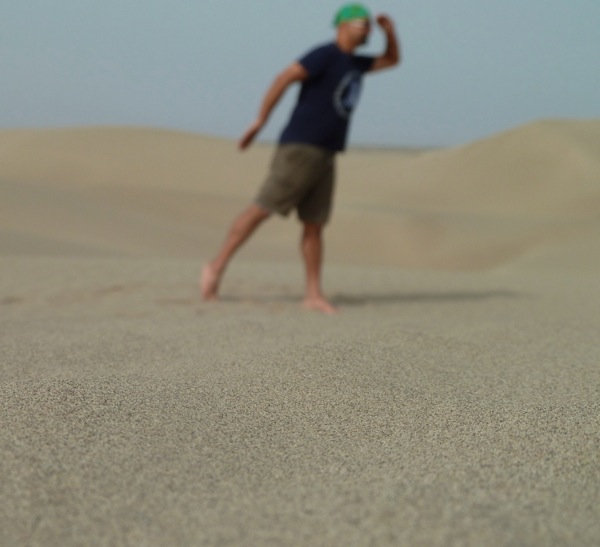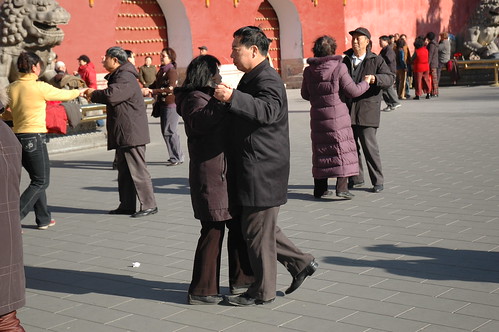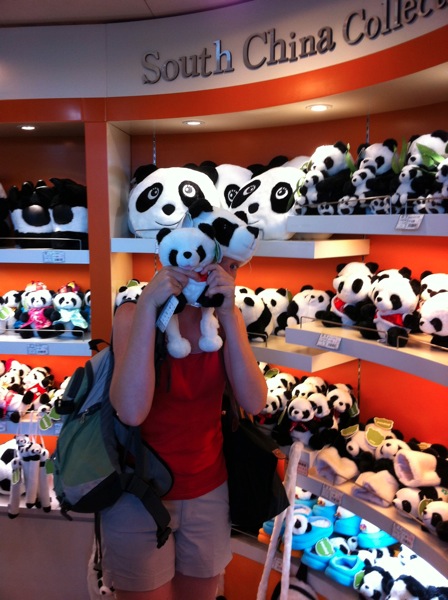[Ed. Note: This post is 4 months late. The trip was 8/15 to 9/10/11. Now that no one cares, I thought I’d post about it. 🙂 I’ve been trying to write this for months, but really I was too focused on this project at work to make it happen… Â If you want to just look at my PICTURES, here they are, but I think the pix are better if you read this post & vice versa…]
[Ed. Note II: I was in China for less than a month. I saw a tiny, tiny, fraction of the country in terms of square miles. Â I met maybe 150 Chinese people. Â I had more than a “Hi, can I buy that?” conversation with maybe 10 (being REALLY generous). Â Nonetheless, I’m about to post something now that makes vast sweeping generalizations about an entire nation of over a billion people and thousands of years of history, with languages I can neither read nor write. Â So please accept everything I say here as gospel from someone who knows everything. Â I certainly do.
In all seriousness: I hope I don’t offend anyone (esp. my Chinese friends) with my thoughts and impressions – I really am just trying to understand what I saw & felt while in a fascinating and very different place.]
Â

Â
Our hero in the Great Taklamakan Desert
Â
A few months back, I was whisked off to China by my girlfriend to experience her step-mother country. Â Kimberly, although pretty damn white, has studied Mandarin since she was very young & then majored in Chinese studies in college & lived there for a total of 8 years. Â I knew she was missing China, so it should have come as no surprise when she hijacked our planned trip to India by taking us to China instead.
I recovered from this by planning to trade her for a panda. Perhaps two.
Unbeknownst to me, she subverted that plan by having us head to the far western deserts of China along the Silk Road. Â Pandas are NOT in the desert. Sigh. (She’s tricksy!)
Luckily, I found a new fascination soon after arriving in China: looking for signs of happiness.
But, before we get into that, a brief map:
View China Trip 2011 in a larger map
We landed in Hong Kong, then flew to Beijing, spent a week or so there, and then started heading consistently west, more or less along the route of the Silk Road: We took an overnight train to the ancient capital Xi’an, spent a couple of days there, then took a 26 hr train ride to Dunhuang (sort of the gateway to the West). We then flew to Urumqi, the most remote city from any sea in the world according to Guinness, and the biggest city in Xinjiang, the western-most province. From Urumqi, we flew to Kashgar near the border with Pakistan, and spent a few days there exploring the edge of China, before flying east to Shanghai & then back to Hong Kong.
Our first stop in the mainland was Beijing, a striking and enjoyable city, vibrant and culturally alien with fascinating sights and sounds. Â It immediately made me think of my closest relevant context: large Indian cities like Bombay & New Delhi.
It was similar to those Indian mega-cities but a lot cleaner (well, not the air) and less chaotic. But whereas Indian cities are chaotic, boisterous, and aggressively vivid for all 5 senses, Beijing is a much more somber place, a city made of grey brick and intensely polluted grey skies.
And while a good chunk of the lack of chaos might be explained by the remarkable lack of animals1, that did not explain the collective lack of exuberance: Though the younger generations seem to be having a bit more fun, any forms of public joy, from the small scale, like two people laughing loudly amidst their banter, to something larger, like a crowd enjoying a street performance animatedly laughing and joking, were scarce, at best.2
As this fact began to dawn on me, I became increasingly fascinated. Also, on some level, it was depressing: for an exuberance-based person like myself, I really wanted the Chinese to be having a blast somewhere, sometime. Obviously, just because I wasn’t witnessing it, that didn’t preclude it from happening, but it felt that way pretty strongly & that is how I took it. And additionally, it was alienating: The lack of tangible public displays of happiness made for an even deeper sense of “I don’t belong here”. In hindsight, this makes me realize how much one relies on seeing people emote to connect with them.
The alienness in particular was driven home on the second night in Beijing, when we came across a quintessential piece of my world, done Beijing-style: a large, public, dance party!

Note: This is not my photograph, but it is very to similar to what I saw… (courtesy of edsailor on Flickr)
That night, as we were coming out of a sports arena3, we came across a large group of people of all ages, though mostly older, in the parking lot, dancing. Â There were somewhere between 80 & 150 people congregated outside to dance. Â Big speakers were set up, and there was one woman dancing on top of a platform, Â executing very specific ballroom dance moves. Â Before her were rows and rows of people following as precisely as they could. Â Not a single one was smiling that I saw.
I couldn’t imagine they weren’t having fun, but it was really strange. Â The format looked more like an aerobics class for all ages than anything else, but an aerobics class where everyone was on Ritalin. Â Even more striking was the second group, maybe 50 feet away. Â This group was couples dancing & were doing it UP. Â The leaders were a couple, again dancing efficiently and with great purpose and energy, and all around them were couples & singles executing similar moves with various degrees of skill. Â Again, if I had to bet money, I’d say they were having a blast, but for the life of me, they gave no sign. Â It was bizarre.
A few nights later, as I was free-roaming Beijing by bike, I came across another such pod of couples-dancers. Â The sound system was a large boom box, and this one was just on a wide street corner. Â There were maybe 15 couples, all going at it. Â (All lack of exuberance aside, the coolest thing about this was the fact that large groups of Beijingers have awesome, public, dance parties, on the neighborhood level – that’s pretty cool. Â I wonder if is some hold over from Mao-era public calisthenics or some such.)
My time in Beijing got me thinking about public exuberance & it was in the back of my mind the whole trip. I wondered if its absence might just be a Beijing thing? Â Maybe just as Parisians seem to be more cynical than the average French, or New Yorkers seem more brusque than the average American, maybe something like that was at play? Â But as we went west, the lack of public joy continued. Â The cities were perhaps less grey, mostly due to the lesser concentrations of grey bricks, though the skies of China never improved much (that is enough to make me scream actually), but the people never seemed much more exuberant. Â I think Kimberly and I expected China to become perhaps poorer as we went West, but also somehow, more idyllic, and with that I expected more people who seemed happier.
I realize that this notion is a loaded, bourgeois conceit: that life might get harder and poorer yet simultaneously more happy and soulful, yet I’d be lying if I said it wasn’t in the back of my head. And as much as it is overly romanticized and perhaps a naive expectation of the over-privileged, I do know that my other experiences in developing nations, from Central America, to Africa, to India, were full of poor people with a lot more public expressions of joy in their lives. Thus, as we continued on in China, I was really hoping that we’d start to see the lack of exuberance start to wane, and that we’d stumble across a publicly happier and more relatable existence somewhere.
Â
Xi’an downtown in a storm – one of my pictures from the Flickr set.
Â
Our next stop was Xi’an, the capital city of the first real Chinese emperor (of Terra Cotta Warriors fame (loved them!)). Here, we came to our first Muslim market area, which was lively and fun, full of new foods to try and fascinating things to watch (how do they make that? who are those people? what is that!?). Â We then proceeded to Dunhuang, which was described by friends as a gentle, slow paced oasis (both literally and emotionally) at the beginnings of the great Western deserts of China. Â But the Dunhuang we arrived at was a brand new implanted “if-you-build-it-they-will-come” city of the future, Chinese style, that had supplanted the Dunhuang of old. It was oddly empty, but we were assured that this was a merely a vagary of the tourism schedule of Chinese nationals. In the end, the sand dunes & caves near Dunhuang were beautiful & wondrous, and were certainly worth every minute, but again, no signs of exuberance.
After Dunhuang, we headed into Xinjiang, the vast Central Asian province, home of the ethnically and culturally distinct Uighurs. Â Urumqi, the capital, was a brief stopover for us, notable mostly for a serious security presence (If I were a Uighur, it would definitely feel like it was “Occupied Urumqi”). Â We then headed to our “official goal” of the trip, the old central Asian city of Kashgar & Lake Karakul4 nearby.
Kashgar was a fascinating city with an older, dirty, charming, messy, Uighur, Muslim Old Town that would have been at home anywhere from the coast of Africa, through the Mediterranean, to northern India: Islamic architecture, tiny windy streets, old stone construction, outdoor vegetable markets & food-stalls, animals being butchered, cooked and sold, a crush of scooters and pedestrians, and the crazy melange of people. Â Here in Xinjiang, life didn’t seem as somber somehow, but honestly it didn’t seem like much fun either. That being said, here the lack of joy seemed to be more of a sign of the political realities of the region rather than cultural: The Old Town had been partially destroyed and rebuilt new-style by the Chinese government ostensibly in the name of “progress”, but that decision seems to have been rescinded or at least halted, in the face of Old Kashgar’s increasingly understood tourist value. Â Nonetheless, a massive and concerted program to makeover the rest of Kashgar into a modern (and sadly routine & dreary) Chinese city was well underway. Â Additionally, the government was clearly very keen on making the vast demographic switch from restive Uighur to a Han Chinese majority as soon as possible.
After Kashgar, our travel superpowers finally decimated by the kryptonite that is Chinese hotel rooms, we flew out to China’s showroom city, Shanghai, and thus back to the first world. Perhaps I was biased a by a gracious host at the end of a long trek (thanks Alan!), but the juxtaposition of history, hypermodernity, and a global power trying so hard to impress, made Shanghai a fascinating delight. The fact that I was finally in a real dense urban center with access to a decent bike would have made Shanghai a favorite, but the additional fact that I could go on really long bike rides late at night and see many layers of Shanghai also brought a sense of connection to a Chinese place that was perhaps the best I’ll ever get.
Thus, between Shanghai’s modernity and my ability to bike it, Shanghai seemed the least alien of all the places I experienced in China. Â Here was someplace I could see a life I understood and appreciated. With my greater level of connection, I was much less jarred by the lack of exuberance. Shanghai just seemed busy, rather than unhappy, as Beijing seemed, or grim, as the West did. In fact if the “Deep-Approved-Way-Of-Life” (note intentional semi-ironic arrogance) had to start somewhere in China, I’d bet on Shanghai (Why not? Chinese Communism started in Shanghai & ‘Deepism is much more fun.)
So that was it for our time in mainland China. Â I never found the public happy. Â I’m not sure why or what that meant. It certainly was depressing though. I think a lot of it must be a cultural reserve. Â Maybe the Chinese have a lot of fun in the privacy of their own homes, but dial it way back in public – I’m sure that is part of it & who am I to judge? Â I also am convinced that the Cultural Revolution must have done a lot to disabuse everyone who survived it of the notion of making any waves in any loud public way. Â That in and of itself seems so sad. Â Maybe it was actually more of a lot of little reasons – certainly just in our trip I got a sense of subtle shifts from the somberness of Beijing, to the grimness of the west, to the too-busy-to-smile feel of Shanghai. Â I really just don’t know, but I’m certainly intrigued. Â I’m looking forward to going back someday & maybe exploring the South? Â Maybe more tropical climes will shake things up….
Â
-‘deep
.ps
I’d be remiss if I didn’t thank Kimberly’s family, Gene & Marsha (& Juanita!), in Hong Kong for providing a vital staging area before our trip and a much needed decompression zone on our way out. Â I haven’t written much about Hong Kong, but that doesn’t mean it wasn’t fascinating, just that I’m tired of writing (this may have been my longest post ever!)
And none of this would have ever happened of course without Kimberly, and if it did happen it wouldn’t have been a thousandth of the trip it was. Interpreter, sherpa, sparring partner, tourist attraction, comic relief & partner in crime, in the end I learned she makes a pretty decent panda substitute too:

K tries to convince me that she is, in fact, a panda.
1. My guess is many Indians eat practically none & thus India has animals coming out its ears, while China seems to eat anything that isn’t people, and thus it has few?↩
2. I was going to write that crowds having a blast were simply not found, but K reminded me of a great little moment in Beijing. We came across a (presumably) Chinese pop star giving a public performance with maybe 200-300 excited fans packed onto a tiny plaza in front of a mall. They were actually having a good time & K recalls how excited that made me.  I think I was also excited by the fact that as she was singing, I was the one who got the “overhead clap along” going which she great fully acknowledged from the stage 🙂↩
3. Duke Basketball in China!! Woot Woot! When we scheduled our trip, I knew my beloved Duke men’s basketball team would be in China for some friendship/exhibition games, but we had no idea the timing would work out so perfectly!  We had a great time at the game though it was a very, very one-sided affair – K even got a tiny moment in the WSJ’s coverage! (click here for video.)↩
4. So it turns out we went to Karakul Lake in China which was a modest lake surrounded by beautiful mountains and a few yerts.  And though we didn’t know better at the time, we didn’t realize until I sat down to write this(!!!) that we never made it to the “real” Lake Karakul, as we intended. That lake is large and probably VERY impressive, and is also across the border in Tajikistan 🙂 ↩
Â
Â
[Ed. Note III: Ok so I’m sneaking in an extravagant 3rd “Ed. Note.” I actually have a lot more little tidbits and  brief thoughts on China, so I made them into a separate post. If you’re interested check it out here – or come back some other time 🙂 I promise it will at least be amusing 🙂 You must learn of Clio Coddle!]


If you continue your Chinese happiness studies you should consider going during a festival time & see what a purposeful holiday looks like.
Loved the meta-narrative about finding happiness (or at least, signs of it…)
I actually just finished reading a book called ‘The Geography of Bliss’ about the author’s travel through some of the happiest (and most miserable) places on earth, and how different cultures experience and define happiness. It’s a breezy and light-ish read, so check it out if you’d like 🙂
Maybe they should start a new public service campaign in India – Keep animals off the roads – eat them!